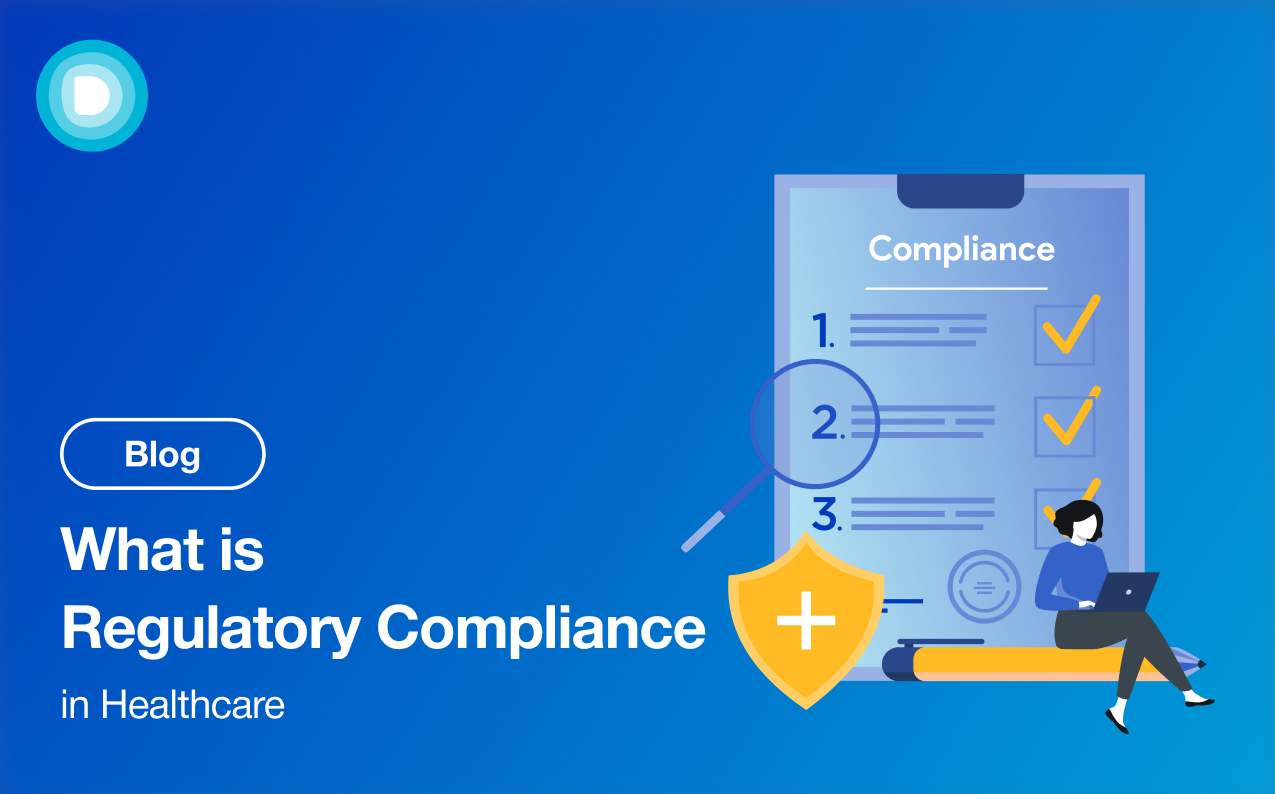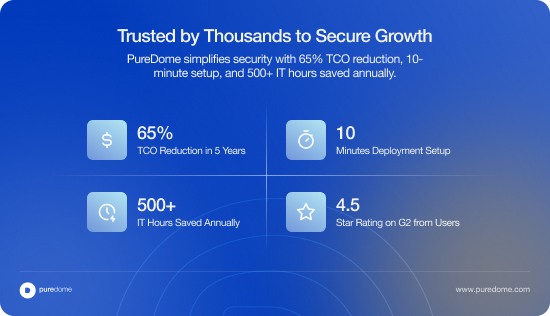- Product
-
Solution
-
By Industry
Cybersecurity solutions tailored to your industry’s needs.
-
- Resources
-
Books
Our ultimate guides and playbooks
Solution Briefs
Overview of PureDome’s functionality
-
Quizzes
Assess your cybersecurity readiness
Case Studies
PureDome customer success stories
Newsletter
Subscribe to the PureDome newsletter
-
- About Us
- Partner
- Pricing
- Download
What is Regulatory Compliance in Healthcare?
-
Aiman Ikram
-
26 Mar 2025
- 4 min read

Have you ever had to fill out endless forms at a doctor’s office, ticking boxes about privacy policies? It’s a hassle for sure. But it’s also a sign that your data is being protected—at least, in theory.
Healthcare is full of sensitive information. Every prescription, test result, and diagnosis is part of a digital paper trail. If that data falls into the wrong hands, it’s not just a privacy issue—it’s a legal and financial disaster.
That’s why regulatory compliance in healthcare exists. It’s the set of rules that keeps patient information safe, ensures medical organizations follow ethical practices and prevents fraud.
Even if this sounds straightforward, it is not.
Laws change and security threats evolve. Because of this, keeping up with compliance can feel like an endless battle for healthcare providers. But understanding the basics—and having the right security measures in place—can make all the difference.
Why Does Regulatory Compliance in Healthcare Matter?
Let’s put it this way: if a hospital’s cybersecurity is weak, it’s not just an IT problem—it’s a patient safety problem. Data breaches can lead to misused medical records, stolen identities, and even interrupted care.
Healthcare organizations have a legal and ethical responsibility to keep patient data protected. That means:
- Ensuring only authorized personnel can access medical records.
- Preventing cyberattacks and data leaks.
- Following strict billing and fraud prevention laws.
- Keeping up with privacy laws and industry standards.
For most providers, compliance isn’t just about avoiding fines—it’s about staying in business and maintaining trust.
The Biggest Healthcare Compliance Regulations
The tricky thing about regulatory compliance in healthcare is that it is different everywhere. Regulations vary depending on country, industry standards, and even the type of medical services provided.
Here’s a quick breakdown of some of the major ones:
- HIPAA (U.S.) – The Health Insurance Portability and Accountability Act is the big one in the U.S. It regulates how patient data is stored, shared, and protected. Fines can go up to $1.5 million per violation, and serious breaches can lead to criminal charges.
- HITECH Act (U.S.) – This law strengthens HIPAA, enforcing stricter security measures and requiring organizations to notify patients if their data is compromised. Fines range from $100 to $50,000 per violation.
- GDPR (Europe) – The General Data Protection Regulation applies to any organization handling EU citizens' data—including healthcare providers. The fines? Up to €20 million or 4% of global revenue.
.png?width=620&height=356&name=Blog%20Body%20Banner%20-%20The%20General%20Data%20Protection%20Regulation%20(2).png)
- ISO 27001 (Global) – While not a law, this international security standard helps healthcare organizations build strong data protection systems. Following it helps reduce security risks and improve compliance with multiple regulations.
- NIST Cybersecurity Framework (U.S.) – Not legally required but widely adopted, this framework outlines best practices for securing healthcare data.
The list doesn’t stop there. Countries have their own versions, and keeping up with them is a full-time job.
What Happens When Healthcare Organizations Don’t Comply?
Regulators aren’t messing around when it comes to healthcare data breaches. Organizations that fail to comply can face:
1. Massive Fines and Lawsuits
Non-compliance is expensive—millions of dollars in penalties, legal fees, and settlements. Anthem Inc. paid $16 million after a breach exposed 79 million patient records. GDPR violations have led to €10 million+ fines for multiple healthcare providers.
2. Cyberattacks and Data Leaks
Hackers love healthcare data. Without proper security, one breach can expose millions of records. The healthcare industry faces more cyberattacks than any other sector. Over 124 million healthcare records were compromised in 2023 alone.

3. Loss of Patient Trust
A security breach doesn’t just hurt an organization’s reputation—it makes patients hesitant to share critical medical details.
4. Operational Disruptions
When regulators step in, investigations and audits drain time and resources. Healthcare services can even be temporarily halted.
It’s not just about following rules—it’s about keeping healthcare systems secure and functional.
How Healthcare Organizations Can Stay Compliant
So, how do healthcare providers avoid falling into compliance issues? It comes down to a few key strategies:
1. Train Staff—Regularly
Most compliance violations happen because of human error. Without proper training, even well-meaning employees can accidentally cause security breaches.
- Healthcare workers need ongoing education on compliance rules.
- Annual training keeps everyone up to date with new threats and laws.
2. Strengthen Cybersecurity
Compliance and security go hand in hand. Weak cybersecurity is the fastest way to violate compliance laws. Encrypt patient records so they’re useless if stolen. Use secure remote access for telemedicine and off-site employees.
3. Maintain Clear Documentation
Regulators don’t just check security policies—they want proof that they’re being followed. Keep detailed records of compliance efforts and audits. Ensure all policies are documented and accessible.
4. Use the Right Security Solutions
The right tools make compliance easier. Secure storage, strong access controls, and network security solutions are must-haves.
But traditional security measures often aren’t enough, especially with remote teams, telemedicine, and cloud-based healthcare systems.
How PureDome Helps Healthcare Organizations Stay Compliant

At the heart of compliance is data security. And when it comes to security, access control is everything.
Traditional VPNs don’t offer the level of control healthcare organizations need. They allow too much open access, which increases the risk of data breaches. That’s where Zero Trust Network Access (ZTNA) comes in.
Zero Trust Network Access (ZTNA) for Healthcare Security
Many compliance regulations such as HIPAA, GDPR, ISO 27001 require strict access control. Zero Trust Network Access does this by removing trust from the equation.
- Least-privilege access – Employees only get access to the specific data they need—nothing more.
- Micro-segmentation – Prevents breaches from spreading across an entire network.
- Multi-Factor Authentication (MFA) – Adds an extra layer of security to prevent unauthorized logins.
With PureDome’s ZTNA solutions, healthcare organizations can:
- Secure remote access without exposing sensitive data.
- Prevent unauthorized access with role-based security policies.
- Ensure compliance with leading healthcare regulations.
Because at the end of the day, compliance isn’t just about following rules—it’s about keeping patient data safe. And with the right security strategy, it doesn’t have to be so complicated. Learn more about how PureDome helps you stay HIPAA compliant with ease.